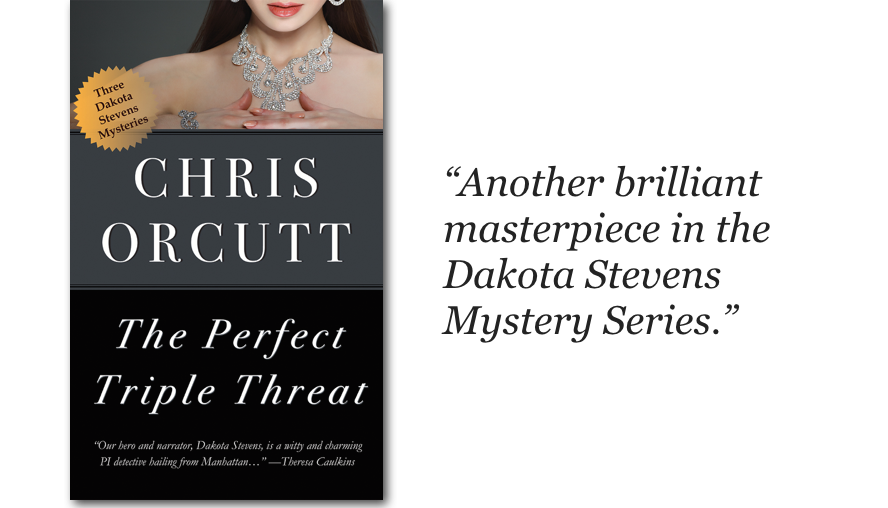
Backstory: The Story Behind The Perfect Triple Threat

The idea for The Perfect Triple Threat, a collection of three Dakota Stevens mystery novellas, didn’t come to me all at once. Rather, the book grew out of tiny, interesting seedlings that got my attention and wouldn’t let it go.
The first glimmers of the book appeared on my radar in the spring and summer of 2015. I had released A Truth Stranger Than Fiction that winter and was burned out from months of radio interviews and publicity work for the book, with remarkably little return in the way of book sales for my efforts. I was burned out and a little bit annoyed with the reading public for not supporting what I considered my best Dakota Stevens novel to date, and I vowed not to write another one for a long time.
The problem is, we novelists don’t have as much say in what we write as we like to think we do, or that readers think we do. Speaking for myself, I don’t have much control over what catches my fancy—ideas, images, stories others tell me—and when a particular item does grab me, and the sentences of a story begin to unfurl effortlessly in my head, it’s incredibly seductive.
In fact, at times the clarity of the words and the scenes revealing themselves has been so powerful, it’s surpassed the highs of sex or any drug I’ve taken. When this happens, it’s as though the story had always been out there, floating in the ether, but invisible until a beautiful Muse spirit chose me to whisper the story to—whispering it in my ear.

Most of the time novel-writing is plain hard work, what I consider the white-collar equivalent of mining. Luckily, however, the Muses favor those who pay homage to them by quietly listening for their guidance, who work hard, who are dedicated and persistent; and they usually shun the dilettantes, the ones who “try” to write, but do it only occasionally, and who don’t finish what they start.
Here’s the deal: If you’re a novelist, when the Muses begin to whisper ideas in your ear, you have to write them down, because if you hear their whispering many times and don’t show them the minimum respect of writing the things down, then they’re going to stop showing up. This includes all of the little “bits” that end up comprising our novels.
In the case of The Perfect Triple Threat, in the spring and summer of 2015, for reasons already mentioned the last novel I wanted to be writing next was a Dakota mystery, but the Muses were giving me those tidbits, and if there’s one thing I’ve always done, it’s respect whatever they want to give me.

One afternoon I was playing golf at my regular club, the 9-hole Vassar College golf course, when the managing pro Rhett Myers told me about an old graveyard between the third green and the ninth fairway, and he drove me up there on a cart to show it to me. The graveyard, enclosed by a decrepit picket fence, held the remains of the original owners of the farm that became the golf course. It dated back to the 19th century and held the remains of the farmer, his wife and their baby, who died before reaching a year old.
Then he drove me over to the 4th tee and pointed out a post up the hill, in the middle of the fairway. He explained that, years ago, his then-greenskeeper, a Mexican man, had been doing some work on the tee one morning when he looked up the hill and saw a giant Native American, with long braids and a bowler hat, standing next to the post. Based on the height of the post, the greenskeeper gauged the Native American to be at least seven feet tall. Spooked out of his senses, the greenskeeper jumped in his cart, raced back to the clubhouse, and told Rhett what happened. He quit his job then and there, and never came back.
Rhett’s story about the 7-foot-tall Native American and the frightened greenskeeper stuck with me, and occasionally as I went through my days that summer, I could feel the gears of my literary grist mill start to grind on this story.
 Then, in October 2015, while staying at a friend’s vacation home in Vermont’s Green Mountains, I began to imagine Dakota and Svetlana there, babysitting their friends’ boys over Columbus Day weekend. When my wife drove up from New York to join me, we drove through the mountains and serendipitously found a town fall festival, with a bake sale, church raffle, games, a used book sale, and dozens of local artisans selling their wares. Once we had walked through the festival, I sat down, ate a couple cider donuts and started to write what became the Dakota novella The Adventure of the Babysitting Detectives.
Then, in October 2015, while staying at a friend’s vacation home in Vermont’s Green Mountains, I began to imagine Dakota and Svetlana there, babysitting their friends’ boys over Columbus Day weekend. When my wife drove up from New York to join me, we drove through the mountains and serendipitously found a town fall festival, with a bake sale, church raffle, games, a used book sale, and dozens of local artisans selling their wares. Once we had walked through the festival, I sat down, ate a couple cider donuts and started to write what became the Dakota novella The Adventure of the Babysitting Detectives.
The idea for the third novella in the collection—The Case of the Fake Reality TV Show—was whispered to me while watching a new Blu-Ray of one of my favorite movies of all time: L.A. Confidential.

Ever since I’d read the works of Raymond Chandler (particularly his novel The Little Sister, which brings his detective Marlowe in contact with movie studios), I’d wanted to write a mystery involving modern-day Hollywood, and the Muses knew it. The other idea, or trend, that they drew my attention to, that they whispered in my ear, was how “reality” TV shows were becoming increasingly less plausible, less based in reality, than ever. Also, they’d had to become increasingly edgy, to the point that I asked myself, “I wonder when they’ll base one of these shows on illegal activities—like burglaries, say—and they’ll have to produce and film it guerilla-style?”
And with that, I had the general concept behind the third novella in The Perfect Triple Threat.
Since writing this collection, in the background or between my much larger novel projects, I’ve been writing a series of Dakota Stevens mystery short stories. My eventual aim is to produce a collection of gems on par with the best of Sir Arthur Conan Doyle’s Sherlock Holmes short stories.
But novel or short story, everything depends on hearing the Muse, and to hear the Muse, you have to show up every day, listen, and write.

Comments (0)